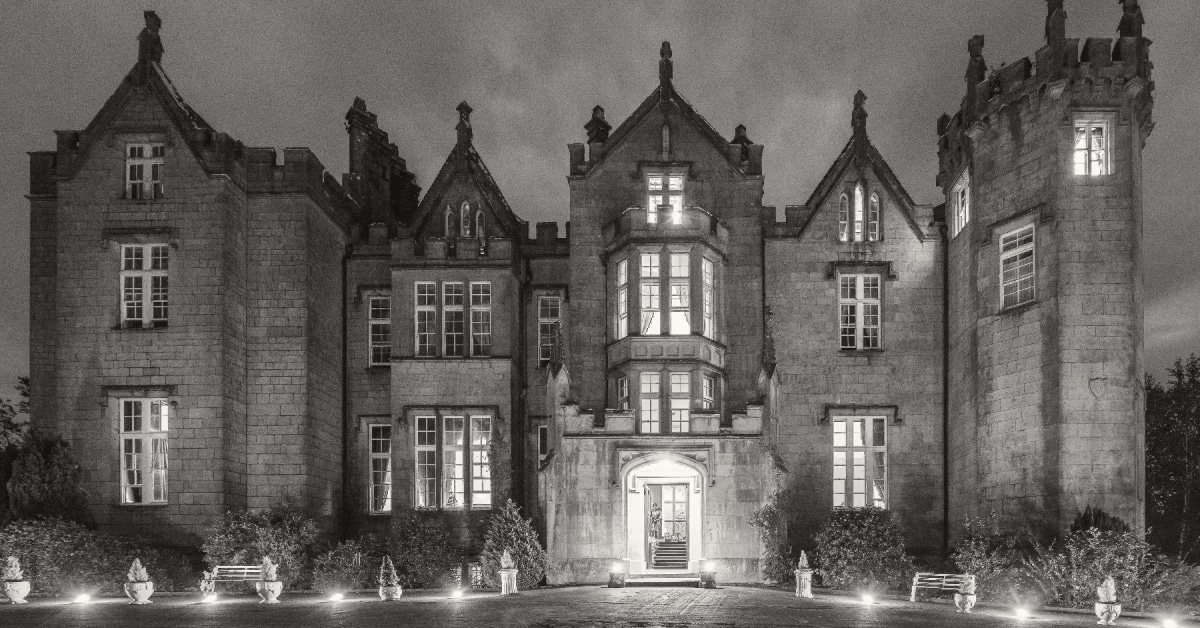Kinnitty Castle History: A Place Shrouded in Mythology

Éire. The very name evokes visions of mossy stone walls separating lush green hills, fairy lights dancing in the morning mist, and a place where mythology is seamlessly interwoven into the fabric of history. It would almost seem easy to step through time in this magical land; cut through that dark forest and you might emerge in the middle of a Norman skirmish, crest that fog-laden hill and you might encounter the legendary Finn MacCool as he slumbers.
The Slieve Bloom Mountains: Where Irish Legends are Born
Evidence of the first civilization in Ireland can be found in Boora Bog in County Offaly, a wet and expansive tract of land. The bog was used to harvest peat in the mid 20th century, but scientists have discovered artifacts on, what would have been the banks of a large lake, dating back to 6800 BCE. Though no permanent structures were found, the arrowheads, ax heads, and blades discovered hint at a nomadic clan who lived and hunted in the vast expanses near Lough Boora and the serpentine pathways of the nearby Slieve Bloom Mountains, one of the oldest mountain ranges in Europe.
The Slieve Bloom Mountains may very well be the birthplace of that enigmatic man of myth, Finn MacCool, who inadvertently ate the Salmon of Knowledge and built the Giant’s Causeway to traverse the channel and defeat his arch-nemesis, the Scottish giant Benandonner. Finn MacCool defended Ireland from many a foe, and, in a fit of rage, uprooted the earth and threw it across the channel, thereby creating the Isle of Man. Some say he never died, instead he sleeps in a cave deep in the mountains, waiting for Ireland to call on him again in a great time of need. So if one takes shelter in a cave while hiking the Slieve Bloom Mountains, be careful not to wake anyone who might be napping.
Kinnitty Castle and Irish Culture Shaped through the Middle Ages
Just north of the Slieve Bloom Mountains, in Central Ireland, sits Kinnitty Castle, a place steeped in history and shrouded in mythology. A place where Paganism and Christianity meet, the natural and otherworldly converge, and the history of Ireland itself is etched in every stone and bramble. It is a castle destroyed, restored, and re-invented many times in its long life. The original land and dwelling was an ancient druidic ceremonial ground built on a powerful leyline. Christianity first appeared on the land of Kinnitty Castle in the 6th century when St. Finnian of Clonard built a monastery on the site. Though the spread of Christianity began to divest the Irish of their druid roots, the connection to the ancient ways is still seen today. It isn’t uncommon to find fairy hills and hawthorn bushes in this part of Ireland, the latter acting as a meeting place for the magical fae. If one wishes to thank or plead a favor from a fairy, one would simply tie a colorful piece of cloth to a branch and whisper a request.
The language and customs of Ireland were further shaped by the arrival of the ambitious Normans who had spent the previous century sacking England, Scotland, and Wales with no sign of stopping. In fact, William the Conqueror’s son was heard to declare, in regards to Ireland, “For the conquest of this land, I will gather all the ships of my kingdom, and will make of them a bridge to cross over”. The Norman acquisition of Ireland took roughly half a century as they slowly chipped away at the loose collection of Gaelic Kingdoms. During the invasion, the original Kinnitty Castle was burned and with it, its history and story lost to us. But wanting to establish feudal strongholds around the county, the Normans quickly rebuilt the castle in 1213.
In the early 1200s, Augustinian monks arrived on the Emerald Isle on the coattails of the Normans and established an abbey, St. Finnian’s, on the grounds of Kinnitty Castle, the walls of which were incorporated into the castle and can still be seen today. The High Cross from this era stands on the banks of the Camcor River. We also have the monks to thank for what is arguably one of the best contributions Ireland has given to the world: whiskey. It is rumored that monks brought the secret of distilling back from their travels around the Mediterranean and quickly made it their own by adding native herbs and spices. Though original uisce beatha, or “water of life” as it was called, wasn’t aged, it paved the way for the centuries of brewing, distilling, and fermenting that have made Ireland famous.
Though Christianity already had a foothold in Ireland in the 1200s, The Archbishop of Canterbury was incensed by Ireland’s retention of pagan culture and customs within Catholicism. He painted the Irish as “barbaric and impious” and, with public sentiment as his weapon, convinced Pope Adrian IV to sanction the simultaneous religious invasion of Ireland. And thus, Catholicism became almost as synonymous with Ireland as whiskey itself. But the land still holds magic, and as a reminder that the veil is thin between worlds, the castle’s ghost in residence, a monk named Hugh, is frequently seen by staff and guests alike, wandering the grounds in his cassock, a silent sentry on this ill-gotten land.
Transformation in the Early Modern Era
Not long after, the property passed to the O’Carroll of Ely family, and the castle was updated in 1630 by William O’Carroll. Many generations later, Charles O’Carroll would move to the New World, drop the “O” in his last name, and plant the first seeds on what would be a thriving plantation in Maryland. Charles’ grandson, also named Charles, is the only Catholic signer of the Declaration of Independence and considered the “First Citizen” by many of his day.
In 1664, the crown granted Kinnitty Castle to the Bernard family who stroked their own ego by changing the name of the property to Castle Bernard. The land stayed with the family until 1946 during which time it received massive renovations in the Gothic style courtesy of famed architect James Pain whose work has become a staple of Irish architectural identity. His designs can be seen in the ivy-covered edifices of Adare Manor and the pirate-deterring towers of Blackrock Castle.
Celtic Revival in the Modern Era
During the 18th and 19th centuries, Ireland was in a full swing Celtic Revival as it tried to recapture some of its roots. Language, art, music, and writing flourished, courtesy of James Joyce, William Butler Yeats, and friends. Historians dusted off many tomes lost to time, and new generations were encouraged to study the myth, language, and history of their ancestors, reaching back beyond the Norman invasion. Suddenly, there was a renewed interest in the lands and establishments that defined Ireland’s history, and the government began funding restoration projects all over the country.
Kinnitty Castle was, once again, burned in 1922, this time by the Irish Republican Army who targeted “big houses” for their connection to the Anglo-Protestant classes of the 18th and 19th centuries. Many castles were blown up or burned down, and most were unsalvageable and demolished, taking irreplaceable pieces of Irish history with them. Others, such as Kinnitty Castle, were restored in time, a testament to the famed Irish will. In 1928, the Bernard family was awarded a government grant to begin repairs, resulting in the majestic structure we see today.
Kinnitty Castle Today: Where New Spirits Come to Life
The castle is currently owned by a group of Irish and American investors including Derek Warfield, founding member of the musical group the Wolfe Tones, and Colin Breen, owner of Four Green Fields Irish Pub in Tampa, Florida and founder of Kinnitty Castle Spirits.
As a tribute to such an enduring legacy, Kinnitty Castle now turns to the spirits created by those monks centuries ago through its initial offerings of premium Irish Whiskey and Irish Gin. Visitors to Kinnitty Castle can experience the spirits that call this place home.



